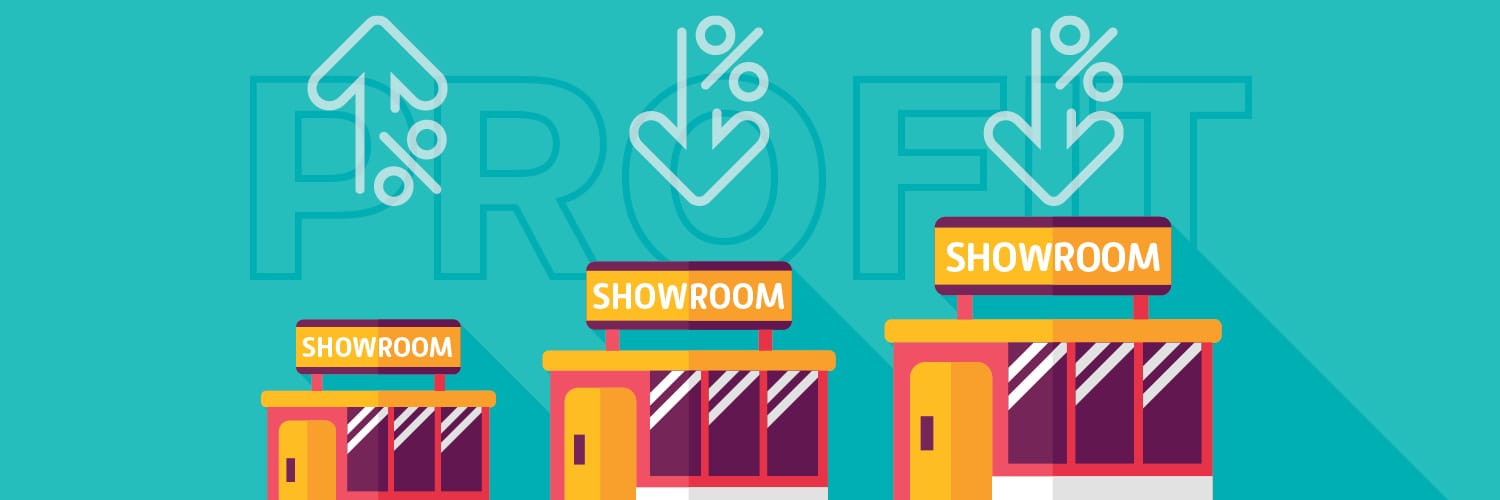A wise person should have money in their head, but not in their heart. —Jonathan Swift
Contrary to popular belief, a bigger showroom does not always translate to increased profit. A bigger showroom is not always better. It might look great, it might be good for your sales designers to earn a nice living, and good for your vendors who relish having so much of their product displayed in your showroom, but a bigger showroom may not be good at all for your bottom line. So how does showroom size actually impact profitability and sales?
Two key ratios can help shape your ideal showroom size
In considering showroom size, there are two ratios to know and monitor. To understand why this theory is true, consider the following two ratios and their byproduct when multiplied together:
Percentage of net profit · TAT = ROA
Here we have a net profit percentage times total assets turnover (TAT) equals your return on assets (ROA). It’s one-half of the return on investment (ROI) formula, and it’s the most critical half.
SEN Business School attendees will be learning that compared to other industries, these ratios need the most attention to earn a better ROI. Here’s a closer look at what each ratio means.
Total asset turnover
TAT measures how well a company manages its current and fixed assets to generate revenue. The better the handling of TAT, the better the number of “inventory turns.” In the kitchen and bath industry, that inventory is of course our displays.
To determine your TAT, divided the total income on your profit and loss (P&L) statement by your total assets listed on your balance sheet. While most industries achieve four to six inventory turns in a year, kitchen and bath dealers typically achieve only two to four turns per year.
Return on assets
ROA measures the profit earned from company assets, including your showroom displays. Showroom displays should be booked as non-depreciable current assets on your balance sheet. This is due to showroom displays being purchased through SEN at such deep discounts that they can almost always be sold at a reasonable profit within a year’s period of time.
Your firm’s ROA is the outcome of its net profit multiplied by its TAT. While most industries achieve a 10% to 15% ROA, kitchen and bath dealers are lucky to record a 6% to 8% ROA.
Boost your ROA by having the right showroom size
From the analysis that we have documented in this article, it is clear that kitchen and bath dealers should focus on improving their return on assets in order to ultimately increase their company’s return on investment.
That’s why it’s critical that each owner size and curate their showrooms so they are optimized to be financially driven.
So what would be the optimum showroom size in most market areas for a kitchen and bath dealer who serves as the firm’s chief sales designer? SEN recommends budgeting for a relatively small, but effective showroom/office space of approximately 1,500-1,800 square feet. Having your showroom within these square footages has the potential to enhance a dealer’s return on assets (ROA) in two ways:
- Earn a greater net profit percentage. Cutting the square footage from the typical 2,000-3,000 square foot showroom size will lower the cost of rent. Rent is usually the third largest dealer expense, after cost of goods sold and personnel. A smaller showroom also effectively lowers utility and maintenance costs as well as any possible common charges.
- Achieve a greater TAT. By cutting the number, size, and cost of showroom displays, the asset investment is reduced. The proper marketing of your services in your showroom, together with an effective media and public relations plan, can produce an even greater income than what a larger showroom with more displays might.
Indeed, most dealers overinvest in their showrooms and underinvest in the requisite marketing that would enable their operations to reach a higher level of profit potential. These dealers often rely too much on word-of-mouth advertising and get hurt financially when a recession settles in.
Optimally, dealers ought to be generating roughly $1,500 of sales per square foot if their showroom meets other SEN recommendations to (a) make it an education center, (b) utilize the Good-Better-Best (GBB) selling concept in its cabinet comparison display, and (c) even more importantly, leverage the GBB sales process embedded as the centerpiece of DesignAlign ™ technology.
To master this GBB sales process all dealers/owners and their sales designers should be attending the SEN One-Day Regional Seminars starting this August.
Some highlights of SEN One Day Regional Seminars
The 2021 regional seminar: “How to Double Your Sales at Higher Margins in Half the Time” will help owners discover the correct pricing for all their projects.
The presentation covers the concept of the three-year budgeting process and answers the question: What net profit does my kitchen/bath business really need to earn?
Dealers and designers who attend will learn how to double their sales using the GBB sales process. They will become far more efficient in securing a quick retainer, which is important in today’s booming market that demands so much of a designer’s time to handle all the leads.
Finally, attendees will also learn why a superior customer showroom experience supports up to 40% price increases for all firms that consistently use the GBB selling process.
It’s impossible to effectively scale operations without a proven, replicable sales process. The One Day Regional Seminars offer proof of why the Good-Better-Best selling system works as well as it sounds, in scaling your business for maximum revenue and profit potential.
— The SEN Design Group Team


